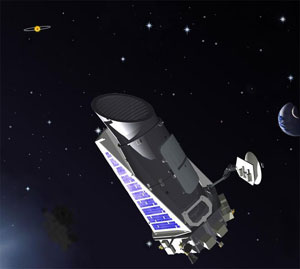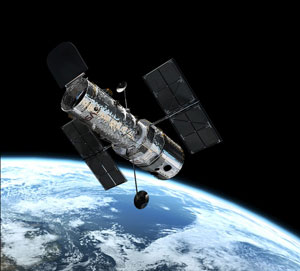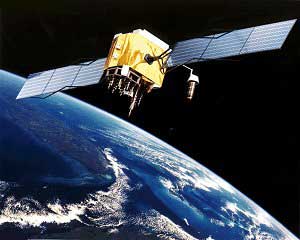Kepler Telescope

Kepler is a space observatory launched by NASA to discover Earth-like planets orbiting other stars. The spacecraft, named for the 17th-century astronomer Johannes Kepler, was launched on 7 March 2009.
The Kepler observatory is "specifically designed to survey a portion of our region of the Milky Way galaxy to discover dozens of Earth-size planets in or near the habitable zone and determine how many of the billions of stars in our galaxy have such planets". A photometer continually monitors the brightness of over 145,000 main sequence stars in a fixed field of view. This data is transmitted to Earth, then analyzed to detect periodic dimming caused by extrasolar planets that cross in front of their host star. (Source: image and text wikipedia)

Hubble Telescope
The Hubble Space Telescope (HST) is a space telescope that was carried into orbit by a Space Shuttle in 1990 and remains in operation. A 2.4-meter (7.9 ft) aperture telescope in low Earth orbit, Hubble's four main instruments observe in the near ultraviolet, visible, and near infrared. The telescope is named after the astronomer Edwin Hubble.
Hubble's orbit outside the distortion of Earth's atmosphere allows it to take extremely sharp images with almost no background light. Hubble's Deep Field have been some of the most detailed visible-light images ever, allowing a deep view into space and time. Many Hubble observations have led to breakthroughs in astrophysics, such as accurately determining the rate of expansion of the universe.

Hubble is the only telescope designed to be serviced in space by astronauts. Between 1993 and 2002, four missions repaired, upgraded, and replaced systems on the telescope.
The telescope is now expected to function until at least 2013. Its scientific successor, the James Webb Space Telescope (JWST), is to be launched in 2018 or possibly later. (Source: image and text wikipedia)

Artificial Satellites
Sputnik 1: The first artificial satellite to orbit Earth.
The first artificial satellite was Sputnik 1, launched by the Soviet Union on October 4, 1957, and initiating the Soviet Sputnik program, with Sergei Korolev as chief designer (there is a crater on the lunar far side which bears his name). This in turn triggered the Space Race between the Soviet Union and the United States.
The United States Space Surveillance Network (SSN), a division of The United States Strategic Command, has been tracking objects in Earth's orbit since 1957 when the Soviets opened the space age with the launch of Sputnik I. Since then, the SSN has tracked more than 26,000 objects. The SSN currently tracks more than 8,000 man-made orbiting objects. The rest have re-entered Earth's atmosphere and disintegrated, or survived re-entry and impacted the Earth. The SSN tracks objects that are 10 centimeters in diameter or larger; those now orbiting Earth range from satellites weighing several tons to pieces of spent rocket bodies weighing only 10 pounds. About seven percent are operational satellites (i.e. ~560 satellites), the rest are space debris. The United States Strategic Command is primarily interested in the active satellites, but also tracks space debris which upon reentry might otherwise be mistaken for incoming missiles.
A search of the NSSDC Master Catalog at the end of October 2010 listed 6,578 satellites launched into orbit since 1957, the latest being Chang'e 2, on 1 October 2010. (Source: image and text wikipedia)
Copyright Timelines Webdesign 2013 - 2020




